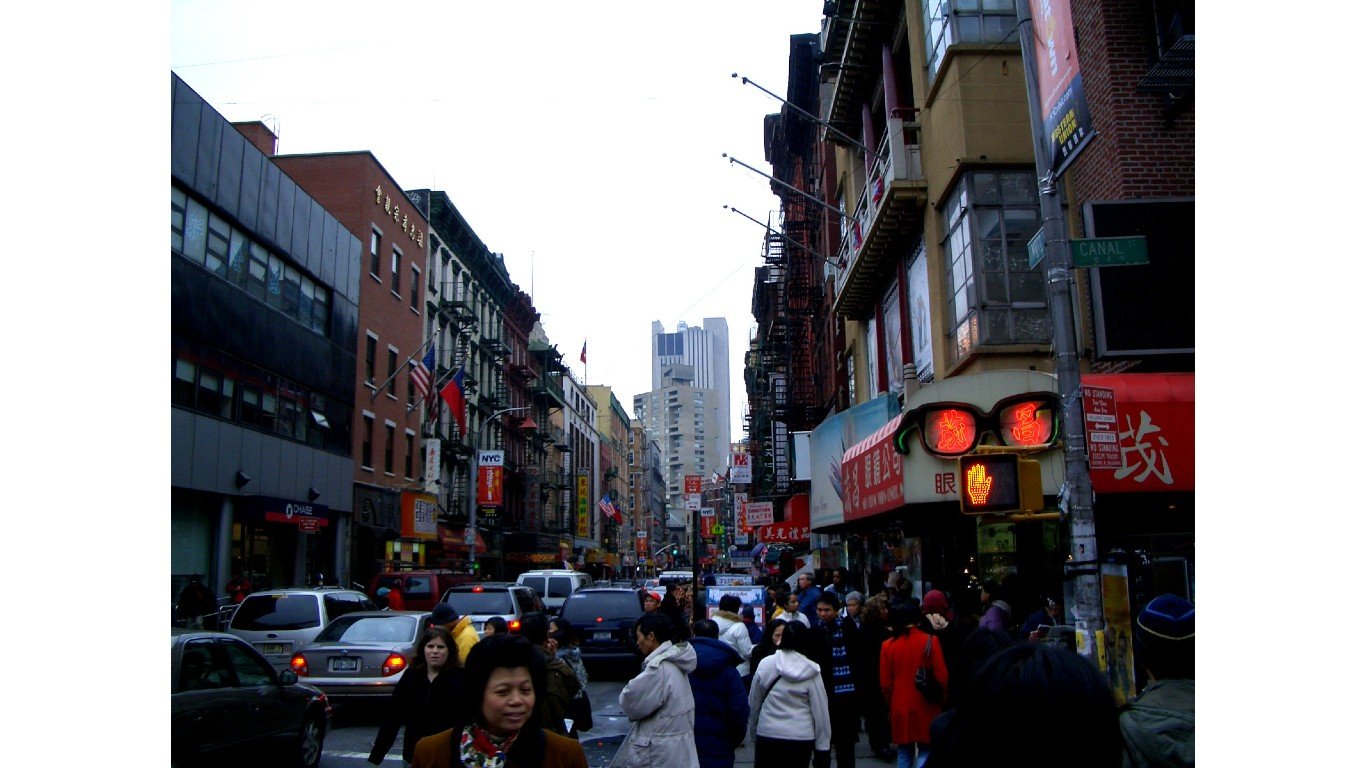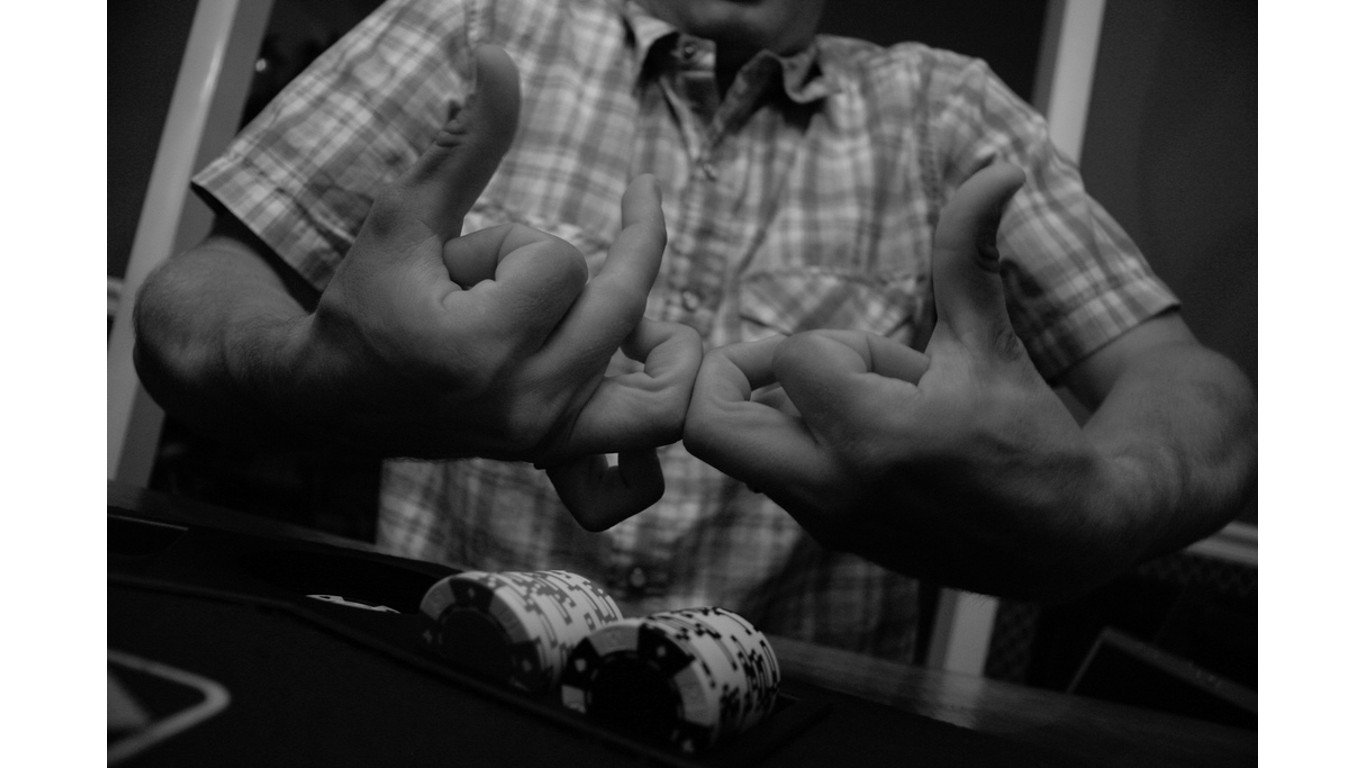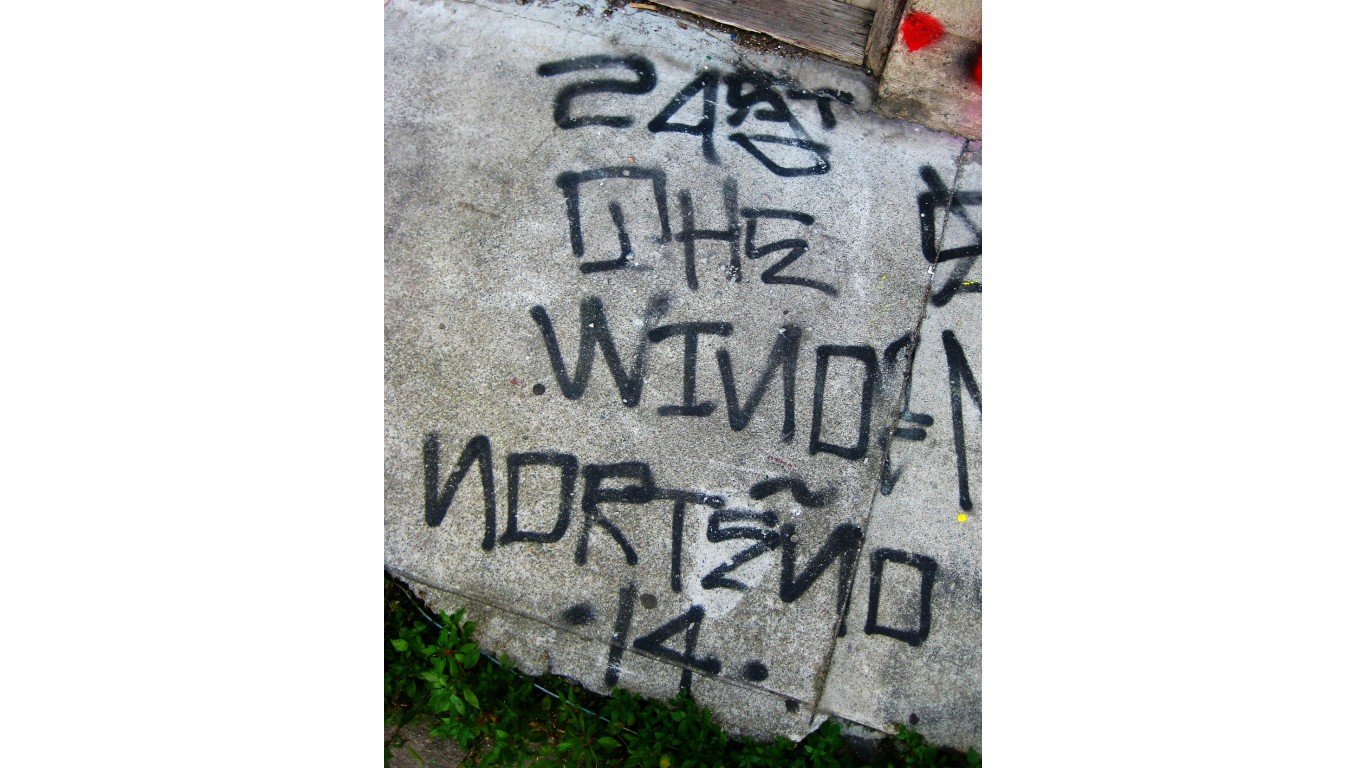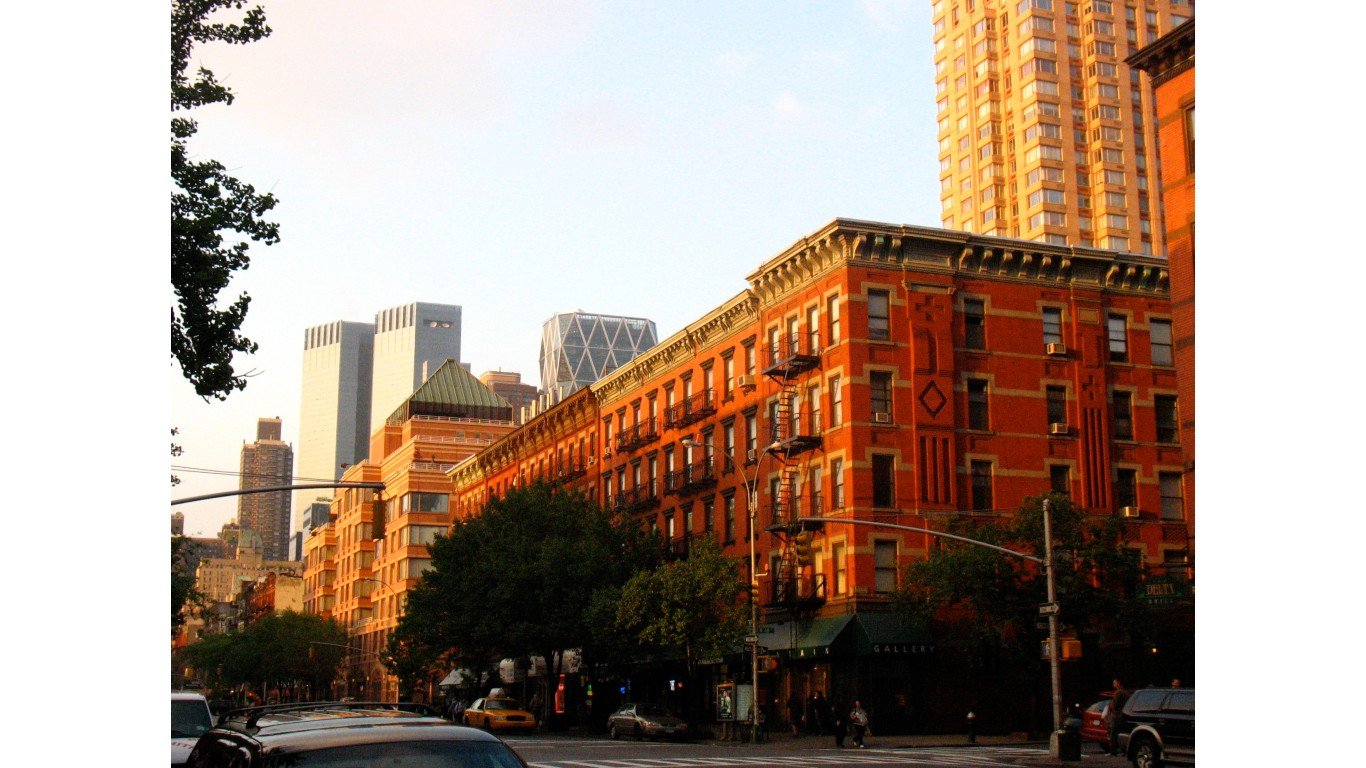Gangs have been around in the world as far back as the 17th century. A Japanese organized crime circuit, known as The Yakuza, is considered the oldest gang in the world, believed to have begun in 1612. Since the early 19th century, gangs have been present in the United States. The first known gang, The Forty Thieves, was comprised of local thieves, pickpockets, and thugs. This criminal gang began in 1826 in the rear of a greengrocer owned by Roseanna Peers, who herself was a known prominent figure in this underworld, and a criminal fence, who intentionally purchased stolen goods to later resell at a profit.
America has long had a fascination with the subculture of criminal gangs, and Mafia figures and other mobsters have long been glorified in novels and movies. In real life, though, no city and no ethnic group in the country has been spared the odious presence of organized criminality. Promotional material for Martin Scorsese’s 2002 movie “Gangs of New York” – based on a group called the Bowery Boys – proposed that “America was born in the streets,” and for many newly arrived immigrants in the 19th century that was so. (These are Martin Scorsese’s movies, ranked worst to best.)
As the nation industrialized and city populations swelled, tensions rose among various immigrant groups who battled for their piece of their adopted country. Poverty and violence were joined at the hip in mid-19th century American cities, and there were few organized city police forces to control the mayhem. The notorious Five Points neighborhood, which birthed many of the earliest organized gangs, appalled Charles Dickens when the English author toured America.
Gangs continued to form in the 20th century as well. Each wave of immigration subjected to discrimination formed gangs to protect themselves – Irish, Italian, Chinese, Albanian, Greek, and Hispanic – and so did African-Americans. Even today, gangs continue to form, although for different reasons. This new influx forms as a way of attention-seeking and many find camaraderie in a group that has never found a familial bond.
24/7 Tempo referenced such sources as History.com, the Crime Museum, the Gangster Museum of America, and American Mafia History.com, as well as numerous other sources to compile a list of America’s most infamous criminal gangs. Our list is far from complete, but concentrates on some of the most famous and/or vicious criminal enterprises, with the final selection based on editorial discretion.
As each ethnic group finds its way into America gang influence tends to diminish, but organized criminal behavior remains very much a threat to American society. According to the FBI, 33,000 violent gangs are operating in the U.S. today.
Here are the most infamous gangs in America
Black Hand

- Place of origin: New York City, Chicago, New Orleans, Boston, Philadelphia, and other cities
- Active years: 1890-1920
- Ethnicity: Italian
One of the precursors of Italian organized crime was the Black Hand, run by gangsters, mostly from Sicily, who extorted Italian businesses and wealthy citizens. They sent notes printed with black hands, daggers, or other menacing symbols threatening death or destruction of property if payments were not made. The group declined during Prohibition.
Genovese Family

- Place of origin: New York City
- Active years: 1890s-present
- Ethnicity: Italian
The Genovese crime family emerged as the ultimate result of the Castellammarese War that ended in 1931 with the assassinations of Old World dons Joseph Masseria and subsequently Salvatore Maranzano. In the wake of their deaths, Charles “Lucky” Luciano became the most powerful gangster in the country, establishing what became known as the Luciano crime family. After Vito Genovese acquired control of the organization in 1957, it took on his name. The family’s reputation of maintaining omertà – refusal to divulge criminal activities or surrender names of criminal confederates – was shaken when former soldier Joe Valachi testified in public about the activities of the Cosa Nostra in 1963.
Gambino Family
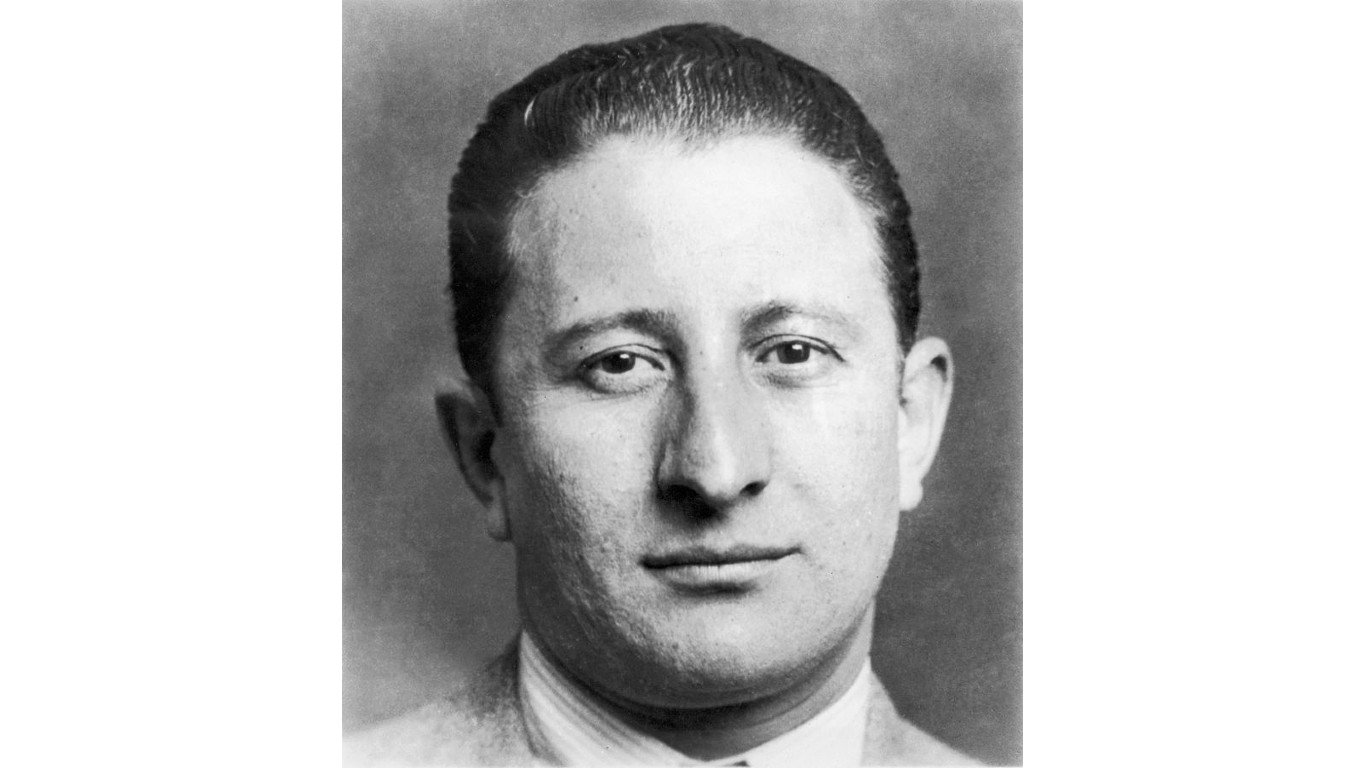
- Place of origin: New York City
- Active years: Early 1900s-present
- Ethnicity: Italian
Under the leadership of Salvatore D’Aquila, the Gambino crime family originated in the early 1900s and became one of New York’s infamous Five Families. It was part of “The Commission,” devised by Charles “Lucky” Luciano, that oversaw organized crime in America. It was run by famous bosses such as Vincent Mangano and Albert Anastasia, but it was Carlo Gambino who substantially boosted the fortunes of the family. This is the criminal organization run by “Teflon Don” John Gotti and remains one of the biggest criminal families in the country.
Bonanno Family
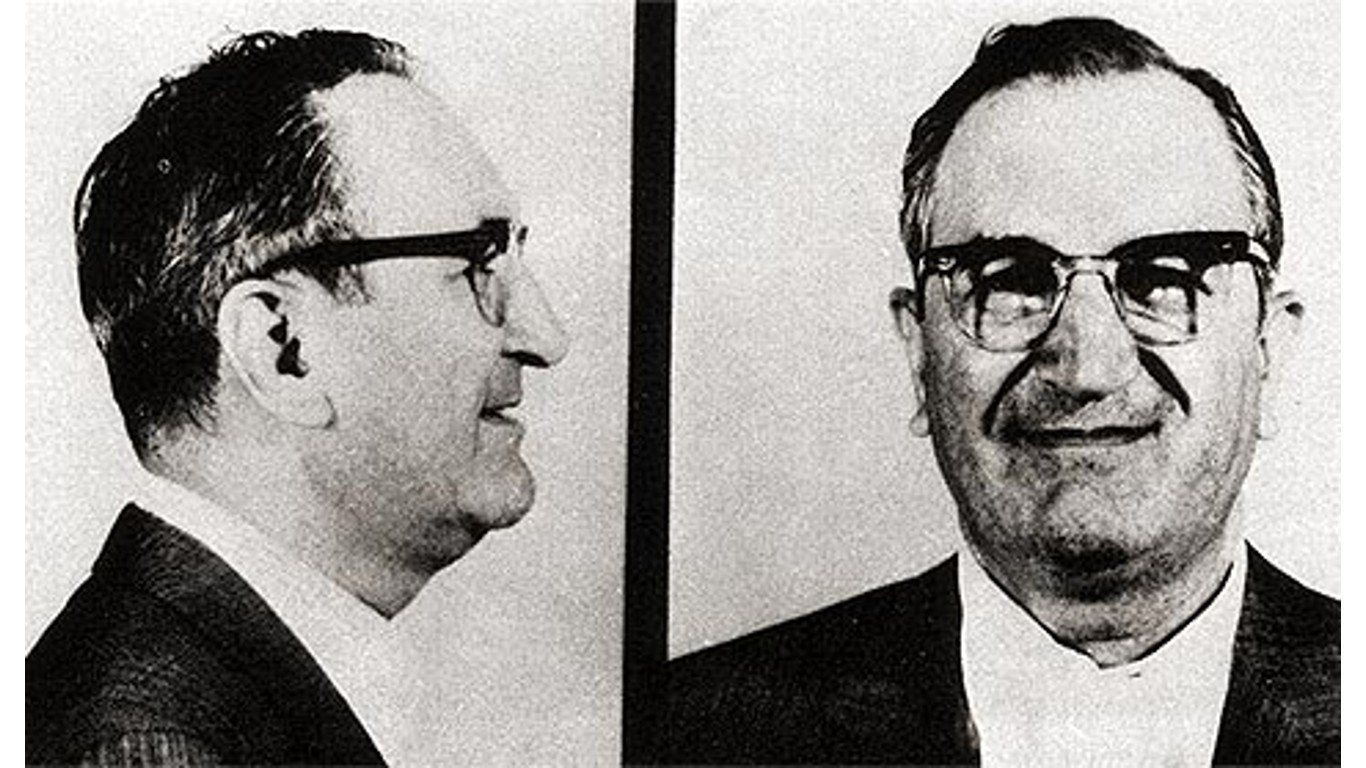
- Place of origin: New York City
- Active years: 1928-present
- Ethnicity: Italian
Another of the Five Families was the Bonanno crime family, which was run by Joseph Bonanno (1905-2002). Bonanno took over the family in 1931 after “Lucky” Luciano and mob kingpin Vito Genovese ordered the execution of Salvatore Maranzano, the crime boss Bonanno worked for. Bonanno managed to avoid jail time until 1980, when, at the age of 75, he was incarcerated for obstruction of justice and civil contempt of court.
Lucchese Family

- Place of origin: New York City
- Active years: 1920s-present
- Ethnicity: Italian
The Lucchese crime family has its origins in East Harlem, where its members emigrated from Palermo and Corleone in Sicily. It is the smallest of New York’s Five Families and has a reputation as one of the more stable and least violent of the Italian gangs. The Lucchese family has focused its activities on iron-fisted control of New York City’s Teamsters and garment district unions.
Chicago Outfit
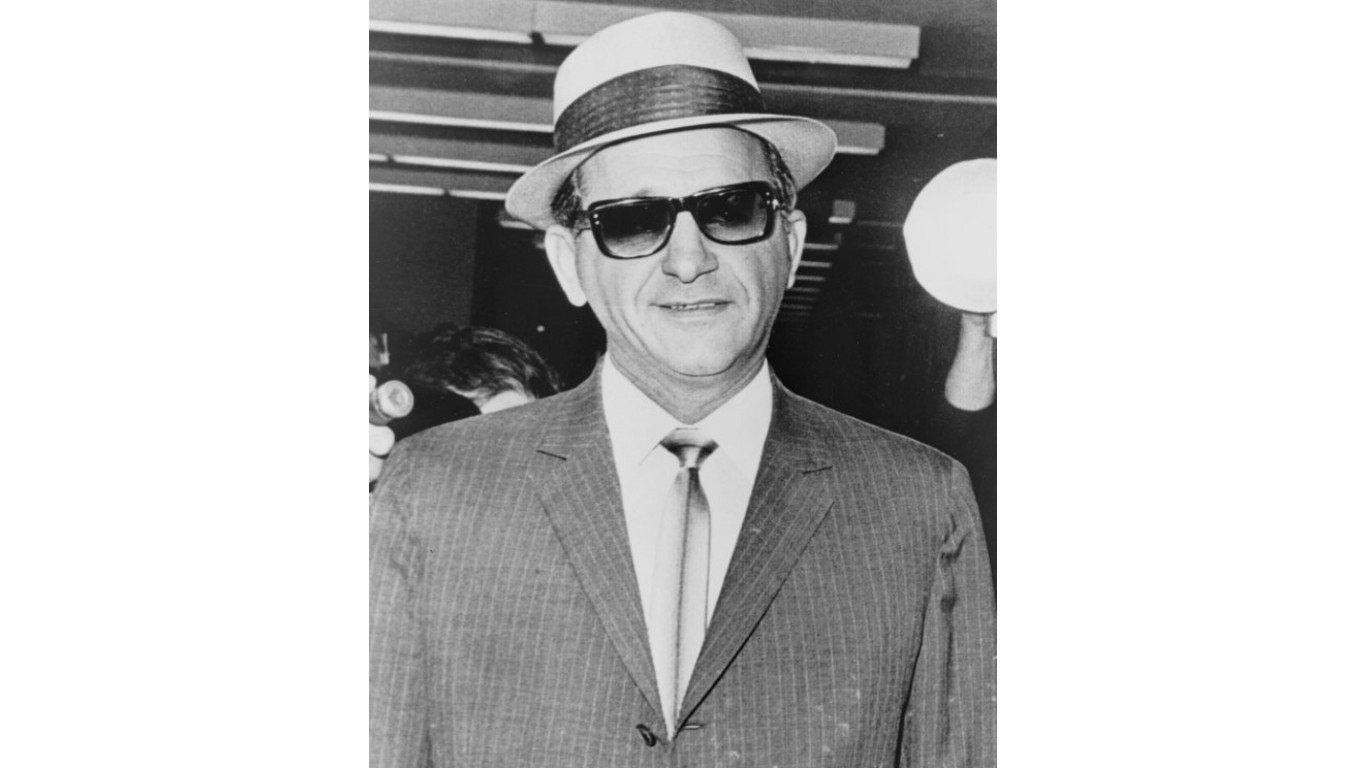
- Place of origin: Chicago
- Active years: 1910-present
- Ethnicity: Italian
Operating around the early part of the 20th century, The Chicago Outfit, part of The Commission, had some of America’s most infamous mobsters in the group. Among them were Al and Ralph Capone; enforcer Frank Nitti; assassin Jack McGurn; mob bigshot Johnny Torrio; and Sam Giancana, the gang leader who allegedly had ties to the Kennedys. The Outfit was likely responsible for the 1929 St. Valentine’s Day Massacre in which seven members of the rival North Side gang were shot by gunmen dressed as policemen.
Colombo Family
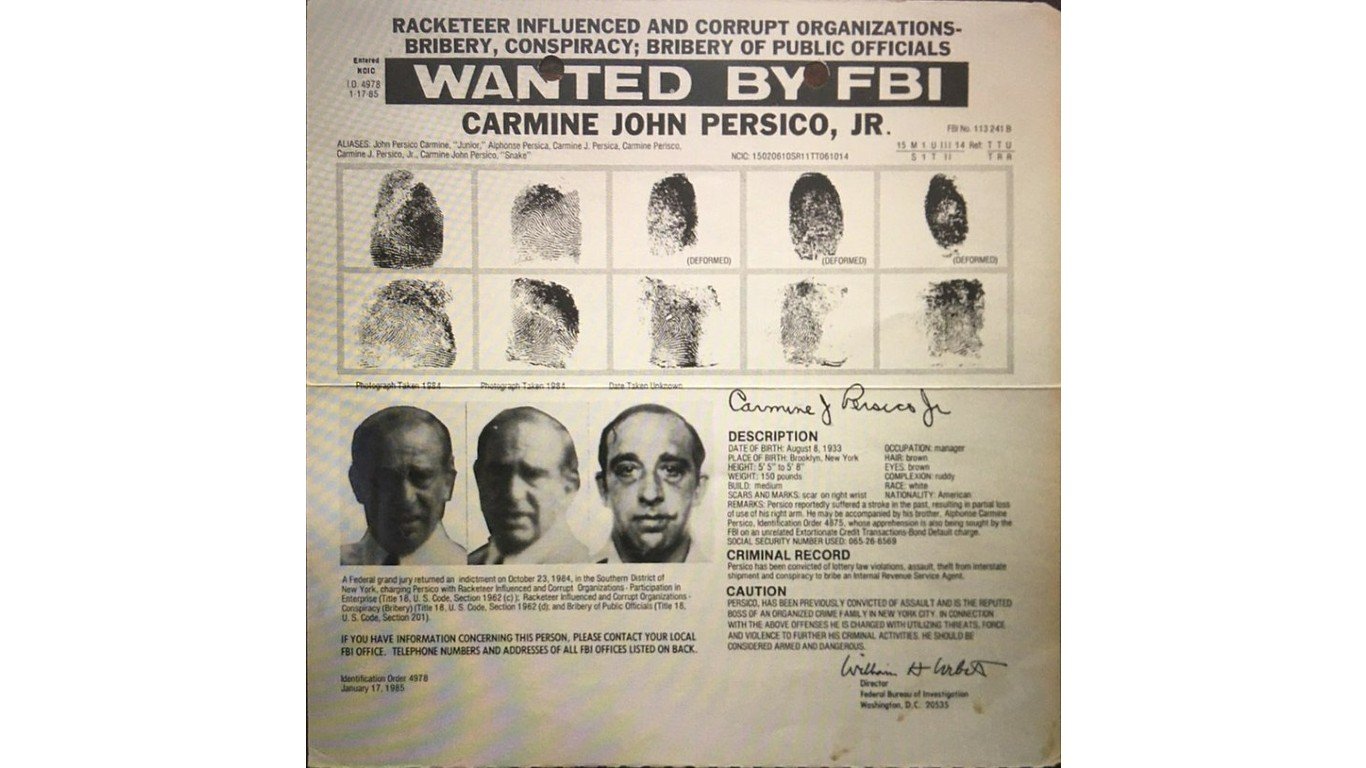
- Place of origin: New York City
- Active years: 1928-present
- Ethnicity: Italian
The youngest of New York’s notorious Five Families is the Colombo crime family. It was founded by Joseph Profaci in 1928, and he remained unchallenged as his family’s boss for decades. Internal peace gave way to strife beginning in the 1950s as a younger generation personified by Joe Gallo sought control. After Profaci died from cancer, Joseph Colombo took over and led the family until he was shot at an Italian-American Civil Rights League rally in 1971. He survived but was paralyzed for the rest of his life. Gallo, believed to be behind the Colombo shooting, was slain at a Greenwich Village restaurant a year later.
Bufalino crime family
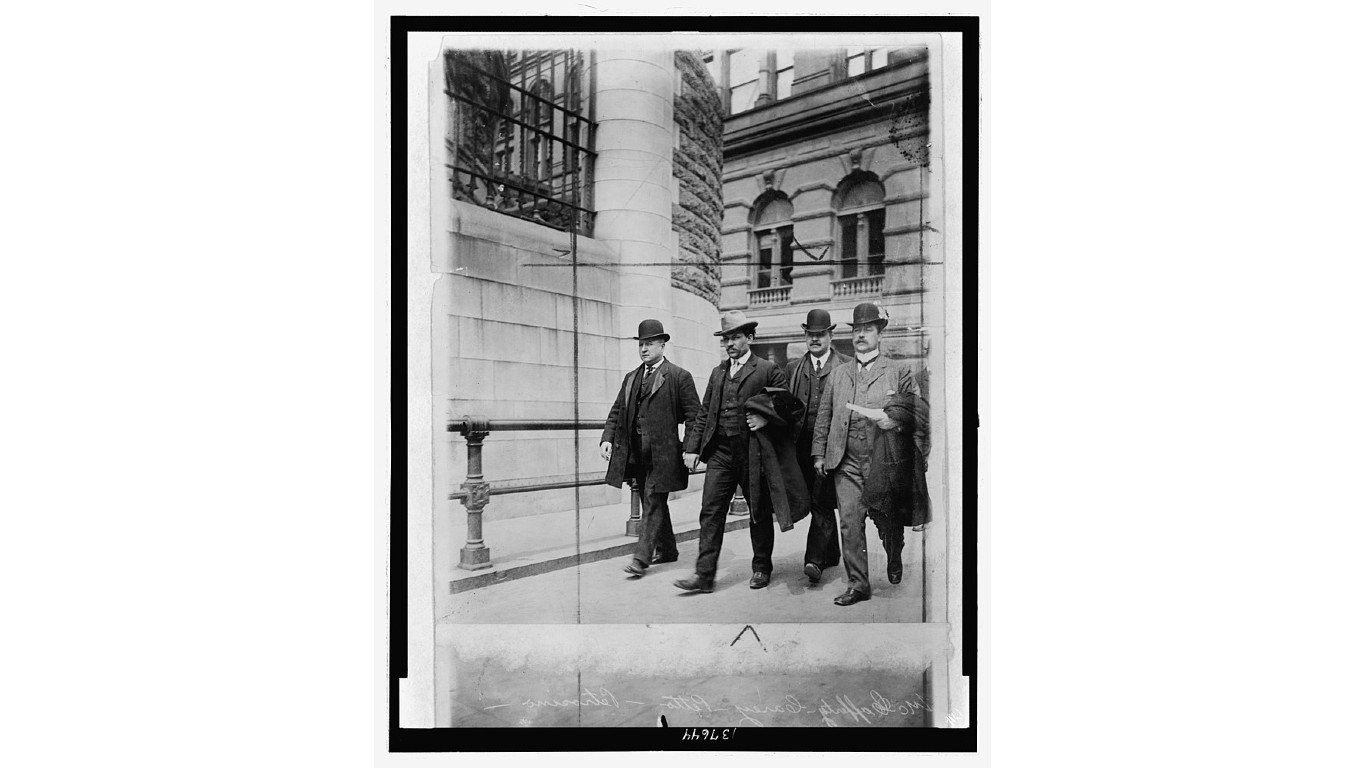
- Place of origin: Northeastern Pennsylvania
- Active years: 1900-2010
- Ethnicity: Italian
Portrayed in the Martin Scorsese-directed gangster film “The Irishman,” the Bufalino crime family is a segment of a Northeastern Pennsylvania crime family. It’s named after Russell Bufalino, who succeeded underworld boss Joseph “Joe the Barber” Barbara in the 1950s. Barbara was famous for hosting the famed 1957 Apalachin Meeting, at which a Who’s Who of Mafia figures gathered in upstate New York for an organized crime summit.
Patriarca crime family
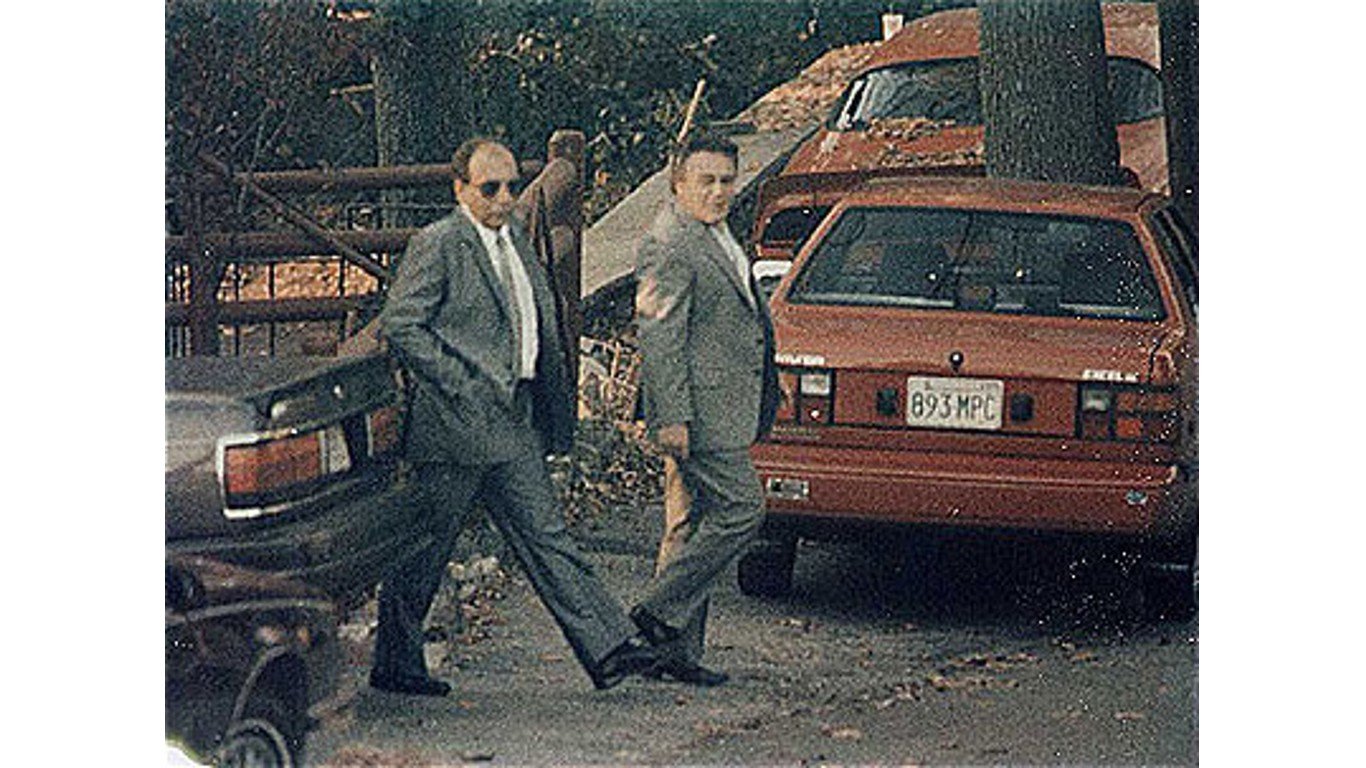
- Place of origin: Boston and Providence, R.I.
- Active years: 1916-present
- Ethnicity: Italian
Founded by Gaspare Messina in 1916, the Patriarca crime family was renamed for a later boss, Raymond Patriarca, who ran it from 1954 to 1984 and dominated the rackets in New England for decades. Patriarca was succeeded by his son Raymond Jr., who was arrested in 1990 under the Racketeer Influenced Corrupt Organizations Act. Internal friction led to a decline in the crime family’s influence. In the movie “The Departed,” several members of the crime family from Providence try muscling into a neighborhood run by an Irish gang and are beaten up by one of the rival gang’s members.
Cleveland crime family

- Place of origin: Cleveland
- Active years: 1920-present
- Ethnicity: Italian
The Lonardo and Porrello brothers, who migrated to the U.S. from Sicily in the early 20th century, started the Cleveland crime family. Joseph Lonardo became the first boss. He controlled the inventory of corn sugar, which was used to make bootleg liquor during Prohibition. In 1926, tensions rose between the two families, and the following year, gunmen assassinated Joseph and John Lonardo inside a barbershop. Joseph Porrello assumed control of the family, but he and his brother Vincenzo were assassinated in turn three years later and the mob was taken over by Frank Milano, who forged alliances with local Jewish mobsters. The Cleveland mob has historically been riven by internal strife and struggles for power.
Philadelphia crime family

- Place of origin: Philadelphia
- Active years: 1911-present
- Ethnicity: Italian
Sicilian immigrant Salvatore Sabella founded this branch of the Mafia in 1911, but it became better known in later years as the Bruno and then the Scarfo crime family. Angelo Bruno, the son of a grocer, took over in 1959 after rising through the mob’s ranks. Considered a competent and loyal soldier who set up gambling rackets for the mob, Bruno was known as the “Gentle Don” for preferring to use bribes instead of violence to settle disputes. His aversion to the narcotics trade and a dispute over control of Atlantic City’s casino operations led to his assassination in 1980. Eventually, Nicodemo “Little Nicky” Scarfo, whose violent behavior and zeal for the drug trade made him the opposite of Bruno, took over the family’s reins. He was eventually arrested and tried on numerous charges and died in federal prison.
Eastman Gang
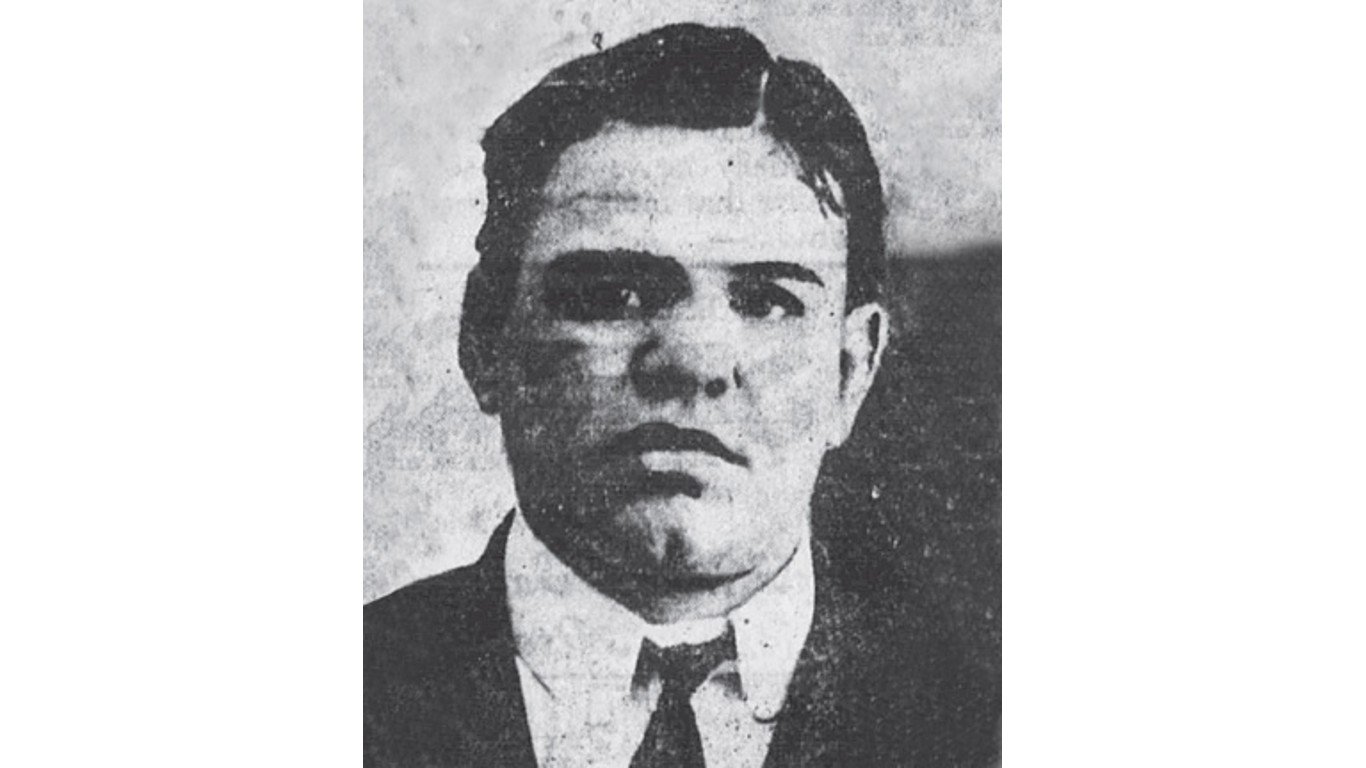
- Place of origin: New York City
- Active years: 1890s-1910s
- Ethnicity: Jewish
One of New York’s most feared criminal organizations was the Eastman gang, led by Jewish mobster Edward “Monk” Eastman, who achieved infamy in the 1890s. This gang numbered as many as 1,200 members and associates and terrorized Manhattan’s Lower East Side. The gang intimidated voters and ran brothels, protection rackets, drug rings, and even murder-for-hire operations. Monk Eastman personally administered beatdowns. After he was jailed for a mugging in 1904, his gang disintegrated. Eastman fought in World War I with distinction, but that did not eradicate his past, which caught up with him in 1920 when he was shot to death by a corrupt federal agent.
Bugs and Meyer Mob
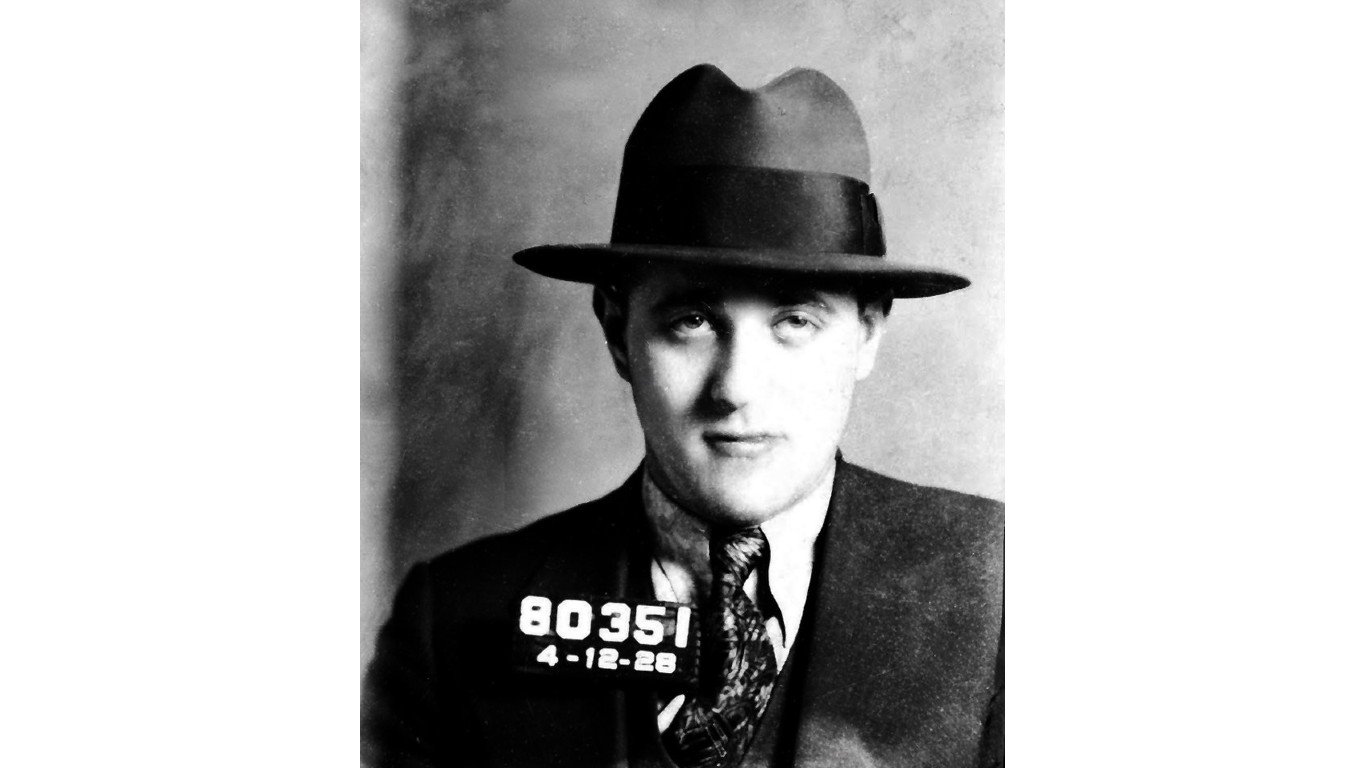
- Place of origin: New York City
- Active years: 1920s-1930s
- Ethnicity: Jewish
The Bugs and Meyer Mob was led by Benjamin “Bugsy” Siegel and Meyer Lansky. The two met on Manhattan’s Lower East Side as teens. Siegel was considered the muscle and Lansky the brains of the group. They allied themselves with Charles “Lucky” Luciano and other Italian mobsters. Siegel was allegedly one of the assassins of mob boss Joe Masseria in 1931, paving the way for Luciano to assume control of the New York underworld. Lansky and Luciano created the National Crime Syndicate in the early 1930s.
Purple Gang
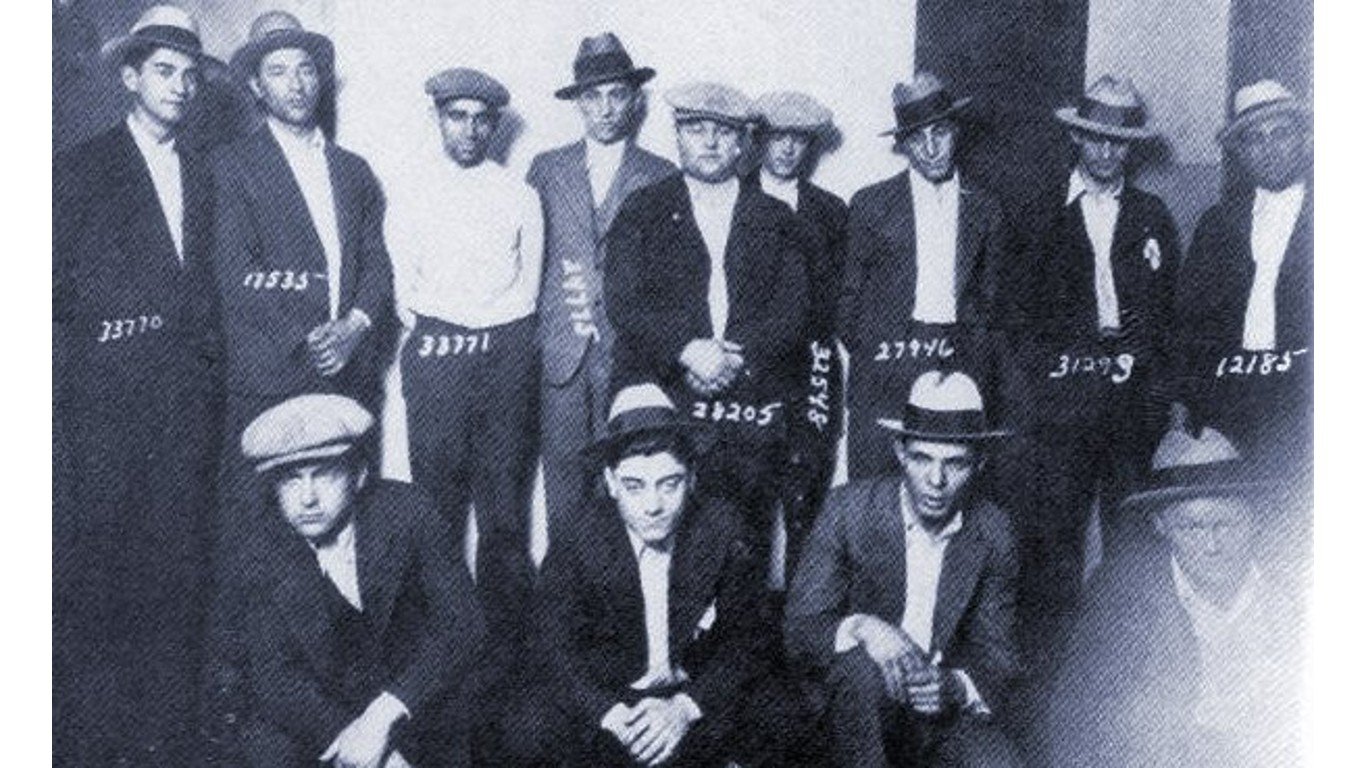
- Place of origin: Detroit
- Active years: 1910s-1932
- Ethnicity: Jewish
The Purple Gang, led by the four Burnstein brothers: Raymond, Joseph, Isadore, and Abraham, were Jewish mobsters who came from the city’s Lower East Side. The origin of their name is murky. It might have come from a shopkeeper victimized by the hoods when they were delinquents, who called them “rotten, purple like the color of bad meat.” Al Capone used the gang to transport whiskey across the Canadian border, but he chose not to encroach on their territory. The Purple Gang controlled gambling, liquor, and the drug trade in Detroit and its vicinity during its heyday in the 1920s. Internal disputes, betrayals, and assassinations led to its dissolution in the 1930s.
Murder Inc.
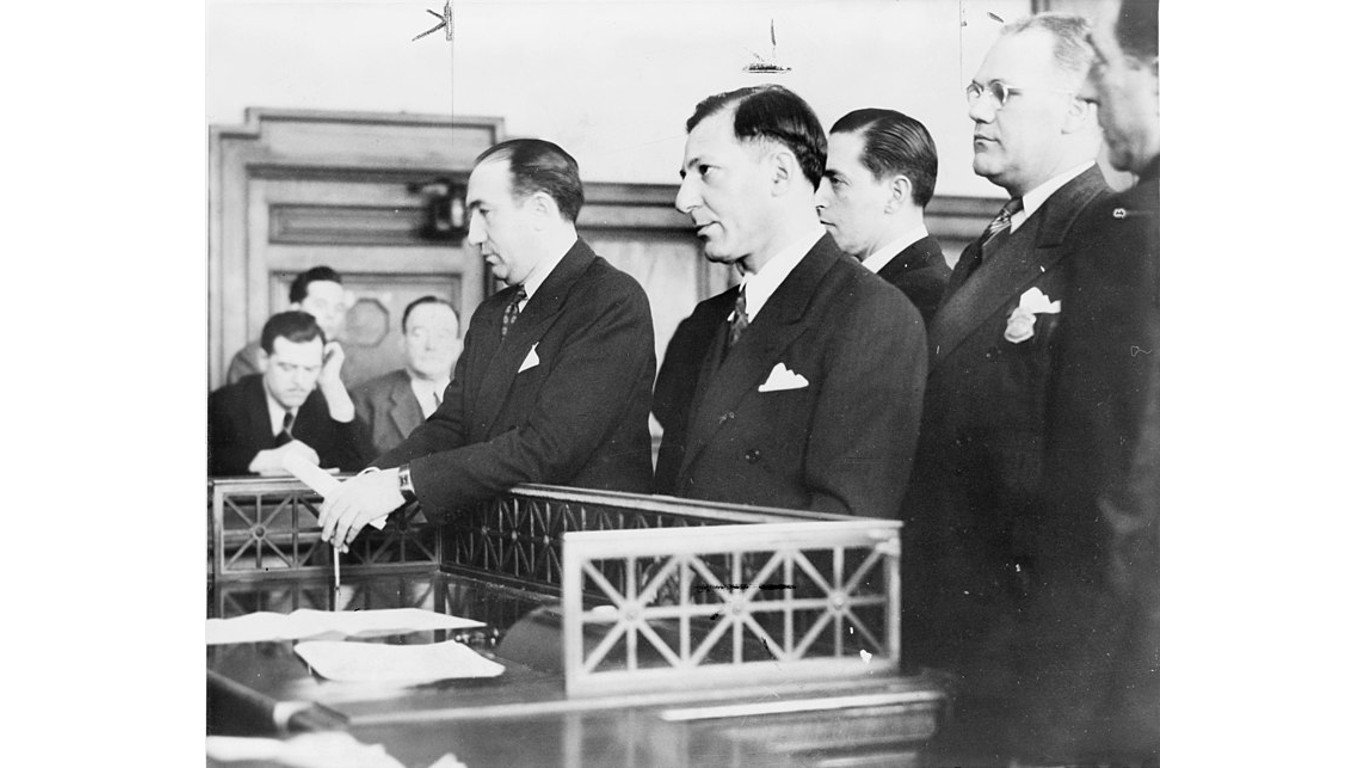
- Place of origin: New York City
- Active years: 1929-1941
- Ethnicity: Jewish-Italian
Murder Inc. was the name the press gave to the enforcement arm of the National Crime Syndicate. The group was led by Louis “Lepke” Buchalter and later by Albert Anastasia. Its services were forged via contracts and available to any syndicate member anywhere in the country. Most victims of Murder, Inc. were other mobsters or those about to talk to law enforcement and were killed for “business reasons.” Benjamin “Bugsy” Siegel was one of the group’s enforcers.
Born To Kill
- Place of origin: New York City
- Active years: 1988-1992
- Ethnicity: Vietnamese
Tho Hoang “David” Thai, who was born in Saigon in 1956 and came to the United States as a refugee following the Vietnam War, formed the gang Born To Kill. After struggling to find a well-paying job, he got involved in the Asian underworld. Thai had developed a lucrative counterfeit watch business and used the money to build the Born To Kill gang, composed of Vietnamese boys younger than himself. With police cracking down on Chinese gangs, BTK took over Canal Street. They developed a reputation for violence and operated brothels with the Italian mob. The group disbanded following the arrests of Thai and other gang leaders.
Bloods
- Place of origin: Los Angeles
- Active years: 1972-present
- Ethnicity: African-American
The Bloods are an African-American gang formed in Los Angeles in the early 1970s. The Bloods were made up of smaller gangs who didn’t want to join the Crips, who dominated gang life in L.A. at the time. As the Bloods expanded in Los Angeles and other cities, including New York, they became more violent. That violence grew in the 1980s as the gang focused on drugs such as crack cocaine. The rivalry with the Crips has become a part of urban lore and has been profiled in movies such as “Colors,” released in 1988.
Crips
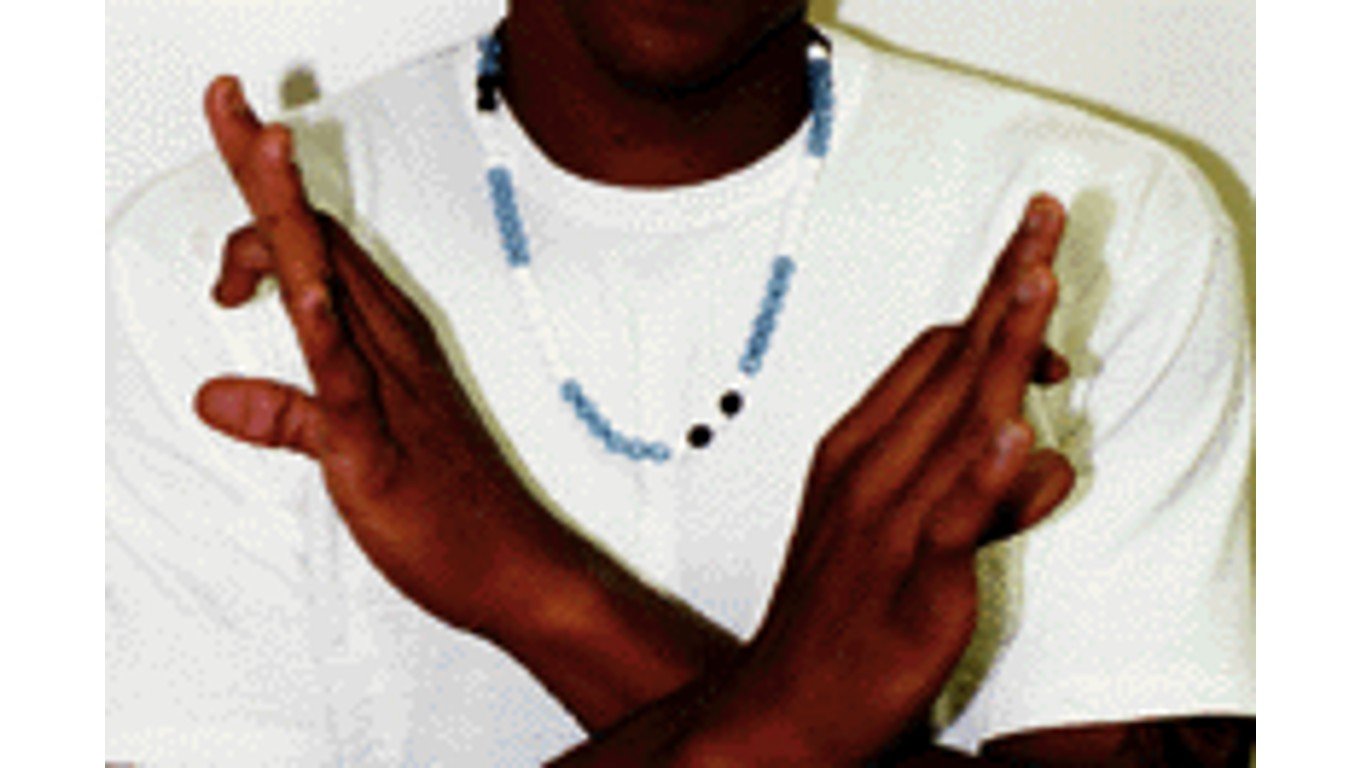
- Place of origin: Los Angeles
- Active years: 1969-present
- Ethnicity: African-American
Founded in 1969 (some sources say 1971) by two pugnacious high school boys, Raymond Washington, and Stanley Williams, The Crips is an alliance between their two groups of toughs, although there is little agreement on how the gang got the name Crips, there is no disputing their strength and use of violence. It has been said that they were originally a political group influenced by the Black Panthers, but Williams wrote a memoir in which he discounted that theory. The Crips exploded in numbers, especially in the 1980s as they became increasingly involved with drugs. They established a presence in 40 states and formed alliances with Mexican cartels. Besides narcotics, the Crips also are involved in auto theft, robbery, and carjacking. To distinguish themselves from the Bloods, the Crips began wearing blue clothing, as opposed to the red apparel of the Bloods.
Aryan Brotherhood

- Place of origin: California prison system
- Active years: 1964-present
- Ethnicity: White
The nation’s oldest white supremacist group, established in the California prison system in 1964 by Irish-American bikers, the Aryan Brotherhood. They were originally formed to protect white inmates after the prison system was desegregated. They have an estimated 20,000 members who can be found in most federal and state prisons around the U.S. Although racist in its origins, the group cares more about money than biased ideology. It has forged alliances with non-white gangs in pursuit of the criminal enterprises of murder-for-hire, armed robbery, gun-running, narcotics manufacturing and sales, counterfeiting, and identity theft.
Bowery Boys
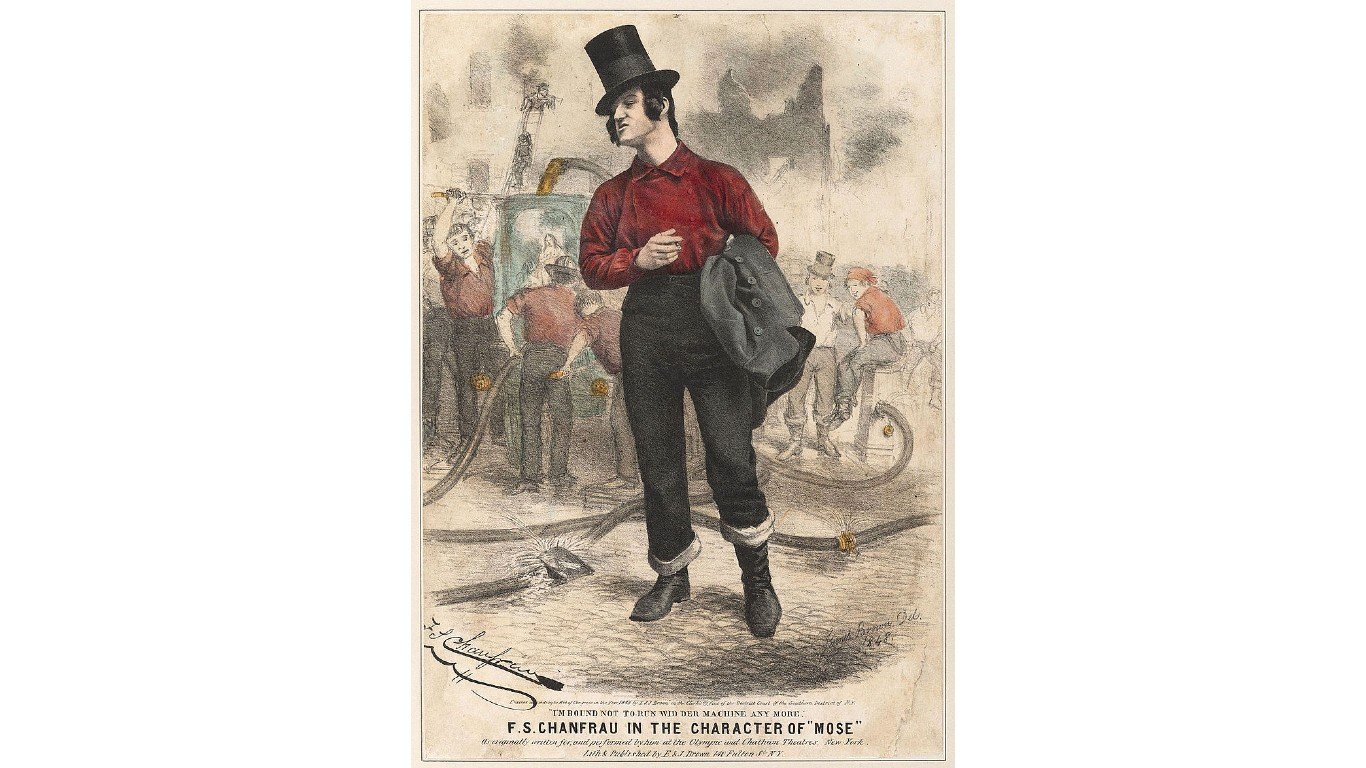
- Place of origin: New York City
- Active years: 1840s-1860s
- Ethnicity: White
Cinemaphiles might remember Martin Scorsese’s 2002 film “Gangs of New York,” starring Daniel Day-Lewis as Bill “The Butcher” Cutting. The character was based on actual gang member William Poole, leader of the anti-immigrant Bowery Boys gang. They clashed with the Irish Five Points gangs during the middle of the 19th century. By day they had legitimate jobs, but off-hours, they engaged in turf wars with gangs such as the Dead Rabbits.
Triads
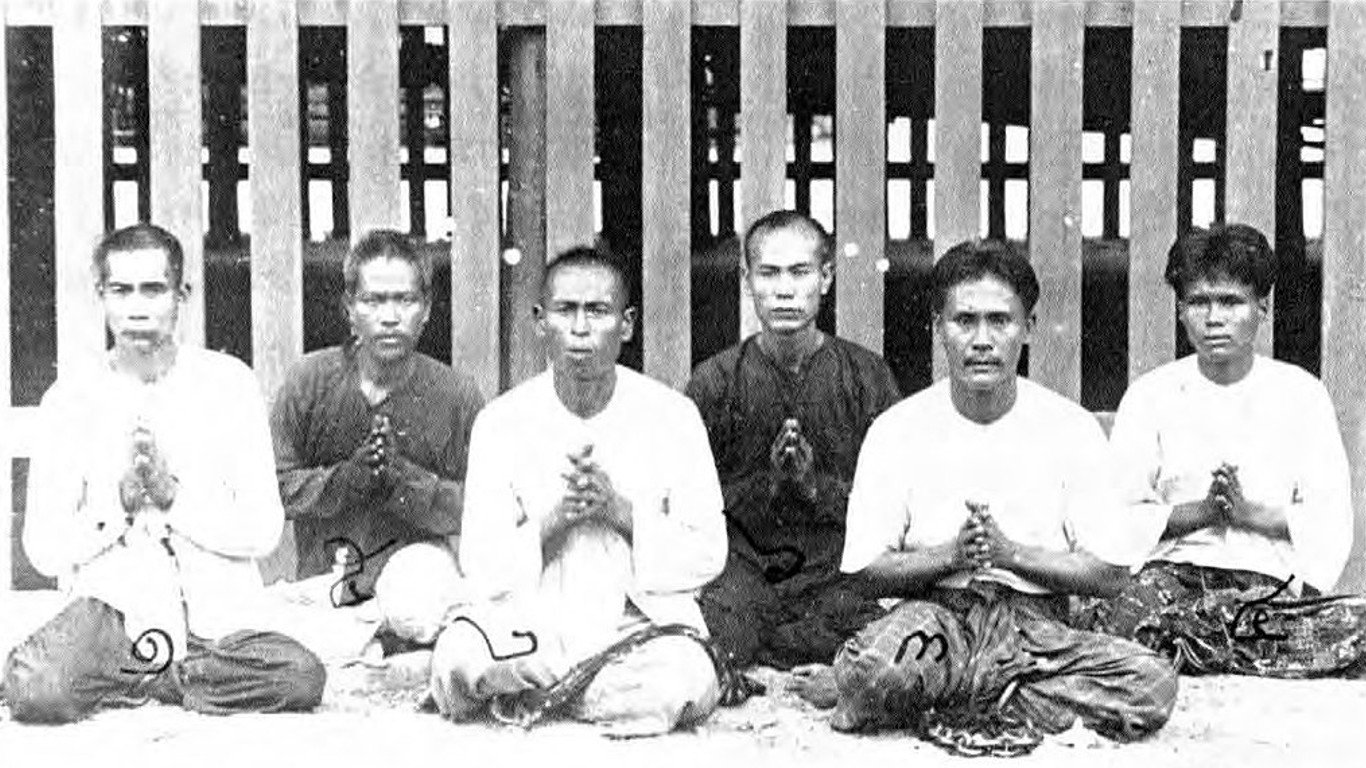
- Place of origin: China, including Hong Kong
- Active years: 17th century
- Ethnicity: Chinese
The term “triad” was used as early as the 17th century to describe secret societies in China. Originally formed primarily in Hong Kong, Guangzhou (Canton), and Zhengzhou, triads have evolved into organized crime families, active not only in China itself (and especially in Hong Kong) but virtually anywhere there is a Chinese community – most definitely including Canada and the U.S. They are active in a wide range of crimes, including drug smuggling, counterfeiting and identity theft, loansharking, and gambling, and increasingly in human trafficking. The groups grew in strength in the 1970s with the arrival in the U.S. of transplanted Asian gangs, and have been known to recruit non-Chinese members, even including some non-Asians.
Tongs
- Place of origin: China
- Active years: 17th century
- Ethnicity: Chinese
Like the triads, with whom they are often confused, the Tongs began as secret societies in 17th-century China. Their modern-day versions were formed in the U.S. during the great Chinese migration in the late 19th century. The newcomers faced intense discrimination from white Americans and other groups and the Tongs started as community support groups. Some remain legitimate organizations, but others devolved into criminal enterprises that controlled opium, prostitution, and gambling. Scott D. Seligman, author of “Tong Wars: The Untold Story of Vice, Money, and Murder in New York’s Chinatown,” said in an interview with Vice magazine that there were four tong wars during the 20th century and they were difficult to stop because not responding to an incitement meant a loss of face.
Nuestra Familia
- Place of origin: California prison system
- Active years: 1965-present
- Ethnicity: Mexican
The Mexican gang Nuestra Familia was formed in the mid-1960s by Hispanic inmates from Northern California in response to what they said was mistreatment by Los Angeles-based gangs under the aegis of the Mexican Mafia. They also fought against other prison gangs, including the Aryan Brotherhood. To join Nuestra Familia, an initiate must commit a violent crime like assault or murder. The FBI began a major crackdown on the group beginning in 2002.
Latin Kings
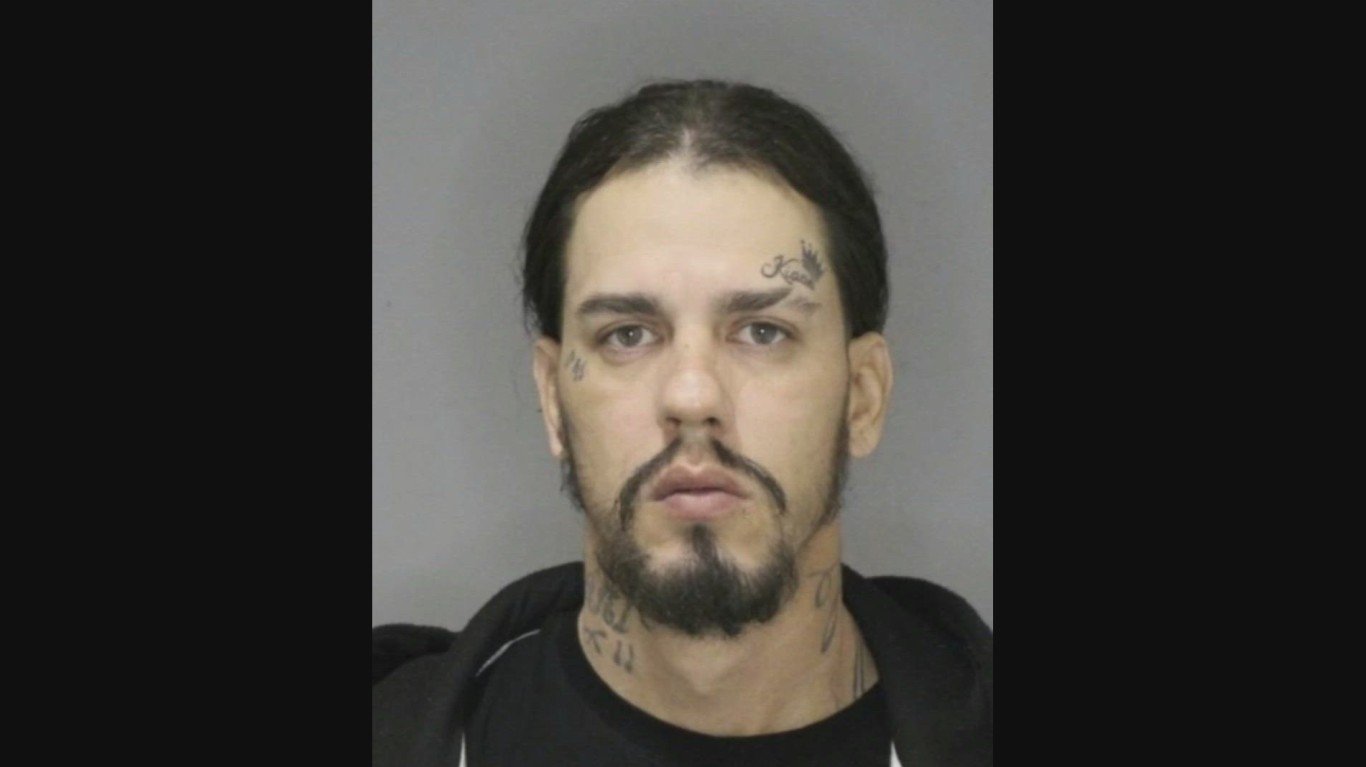
- Place of origin: Chicago
- Active years: 1954-present
- Ethnicity: Puerto Rican
According to the Department of Justice, the Puerto Rican group Latin Kings, formed in Chicago in the 1950s, is a “centralized, authoritarian, violent formal organization complete with a written constitution and by-laws.” Such was their ability to operate gang activity with relative impunity inside the Illinois prison system that the Justice Department recommended that Latin King leaders be removed from the state’s prisons. They have since spread their influence to 34 states.
Russian mafia
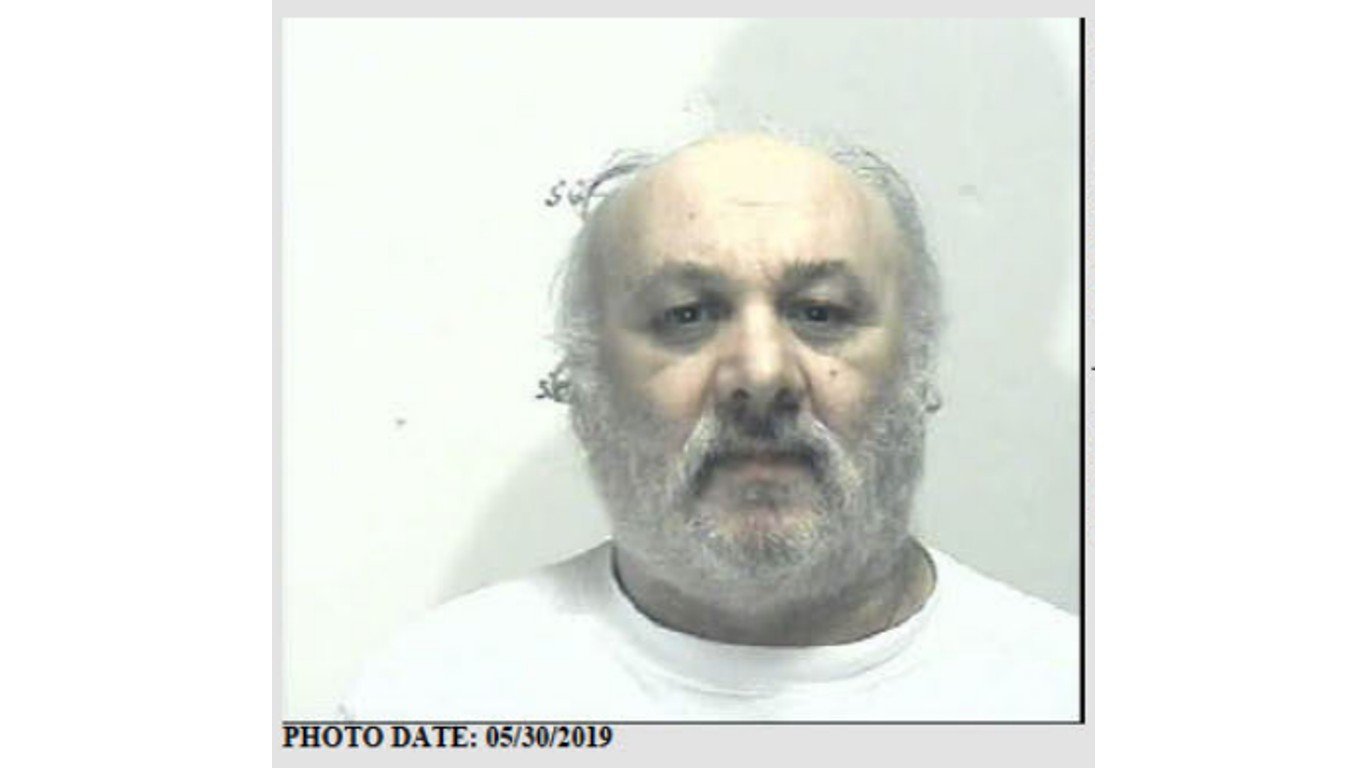
- Place of origin: Moscow
- Active years: Late 1980s-present
- Ethnicity: Russian
There are about 15 loosely identified Russian criminal groups operating in the United States, according to a paper written by James O. Finckenauer of the National Institute of Justice, with as many as nine of them maintaining links to Russia. The estimated total membership of those groups is as many as 6,000. Finckenauer said the criminal networks are neither highly centralized nor dominated by individuals. Extortion and protection rackets are the main areas of Russian gang activity. They are also involved in credit card fraud. Russian gangs have largely avoided the more traditional areas of organized crime, such as drug trafficking, gambling, and loan sharking.
Dead Rabbits

- Place of origin: New York City
- Active years: Mid to late 19th century
- Ethnicity: Irish
The Dead Rabbits were a feared gang of Irish immigrants who prowled the Five Points neighborhood in Lower Manhattan, so named because it was the intersection of five narrow streets. Members rumbled with the Bowery Boys in the mid-19th century – battles brought to the big screen in the Martin Scorsese film “Gangs of New York.” When they weren’t brawling, the Dead Rabbits robbed and picked pockets. It wasn’t just young men doing violence: One of the most feared Dead Rabbits was “Hell-Cat Maggie,” a woman who reportedly filed her teeth to points and wore brass fingernails.
Whyos
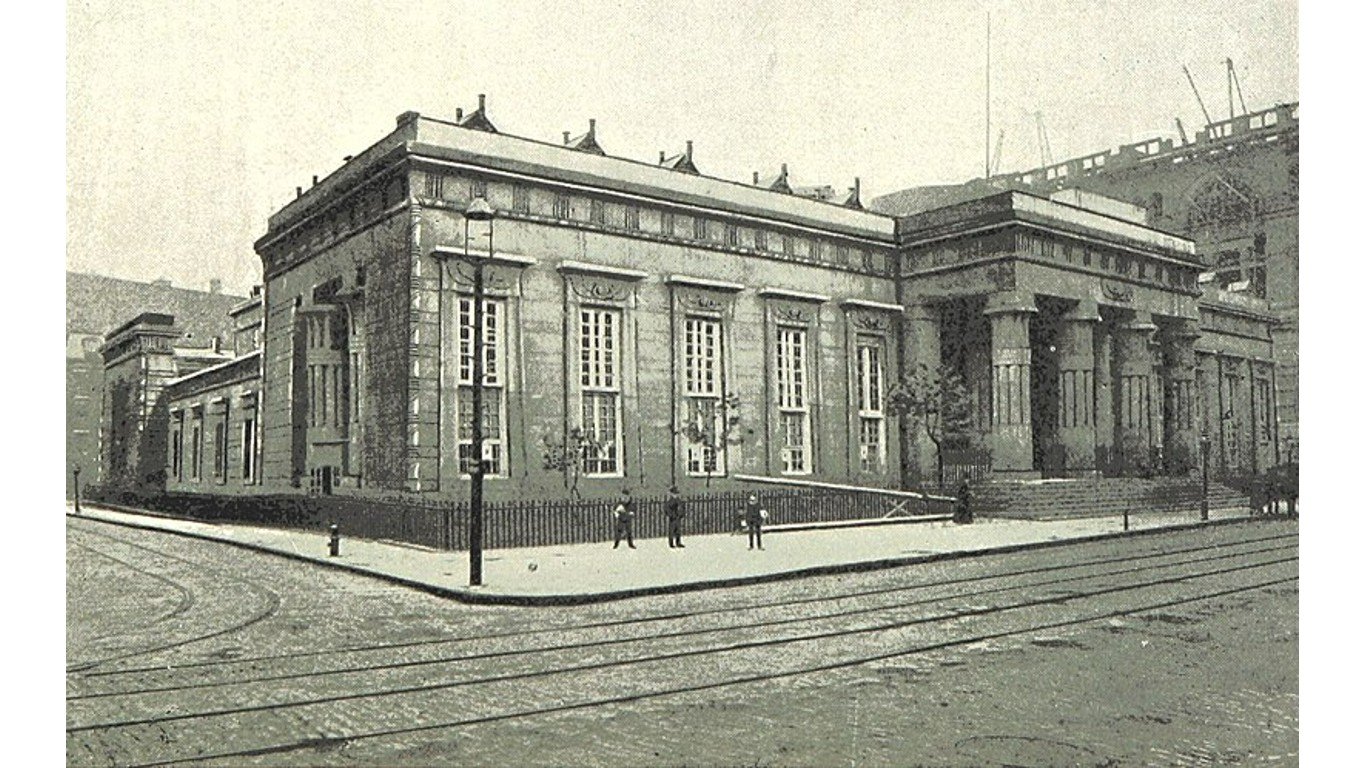
- Place of origin: New York City
- Active years: Mid to late 19th century
- Ethnicity: Irish
Another Irish immigrant group of toughs was the Whyos, who were formed from the remnants of disparate Five Points gangs. They were pickpockets and petty thieves and sometimes murderers who branched out into prostitution and counterfeiting and later used their ill-gotten gains to open casinos and bars. The Whyos were very violent, carrying eye gougers and accessorized shoes with ax blades. Some kept a pricing catalog of nefarious deeds such as the cost of a punch to the face, the chewing off of an ear, and murder.
Boston gangs
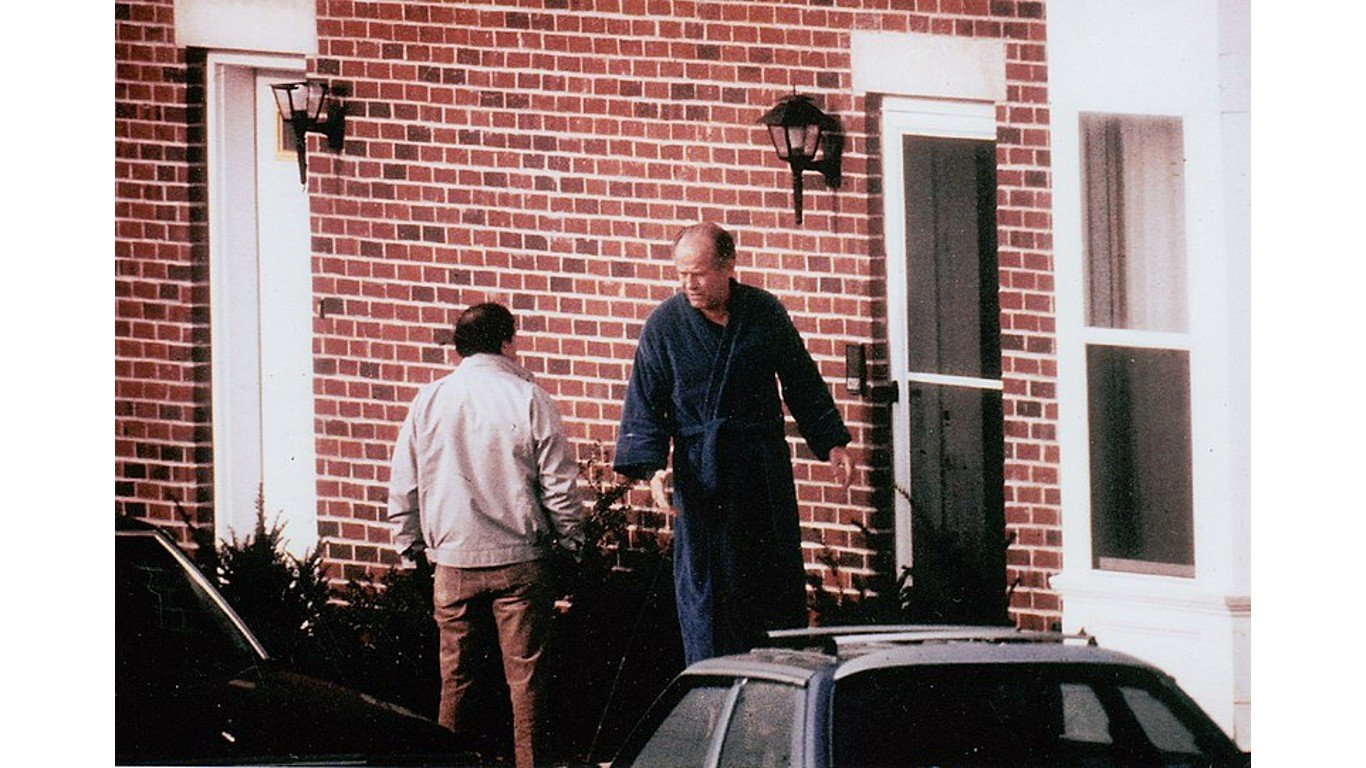
- Place of origin: Boston
- Active years: 1955-present
- Ethnicity: Irish
The two Irish gangs that controlled much of the criminal activity in Boston were the Charlestown Irish Mob and the Winter Hill Gang. The Charlestown Irish Mob was led by the McLaughlin brothers, while James “Buddy” McLean was in charge of the Winter Hill Gang. A gang war erupted in the 1960s in which one of the McLaughlin brothers was killed. This led to the decline of the Charlestown gang. Besides the usual criminal activities of gangs, the Winter Hill Gang also fixed horse races. The most famous leader of the Winter Hill Gang was Whitey Bulger, portrayed by Johnny Depp in the film “Black Mass.”
Five Points Gang
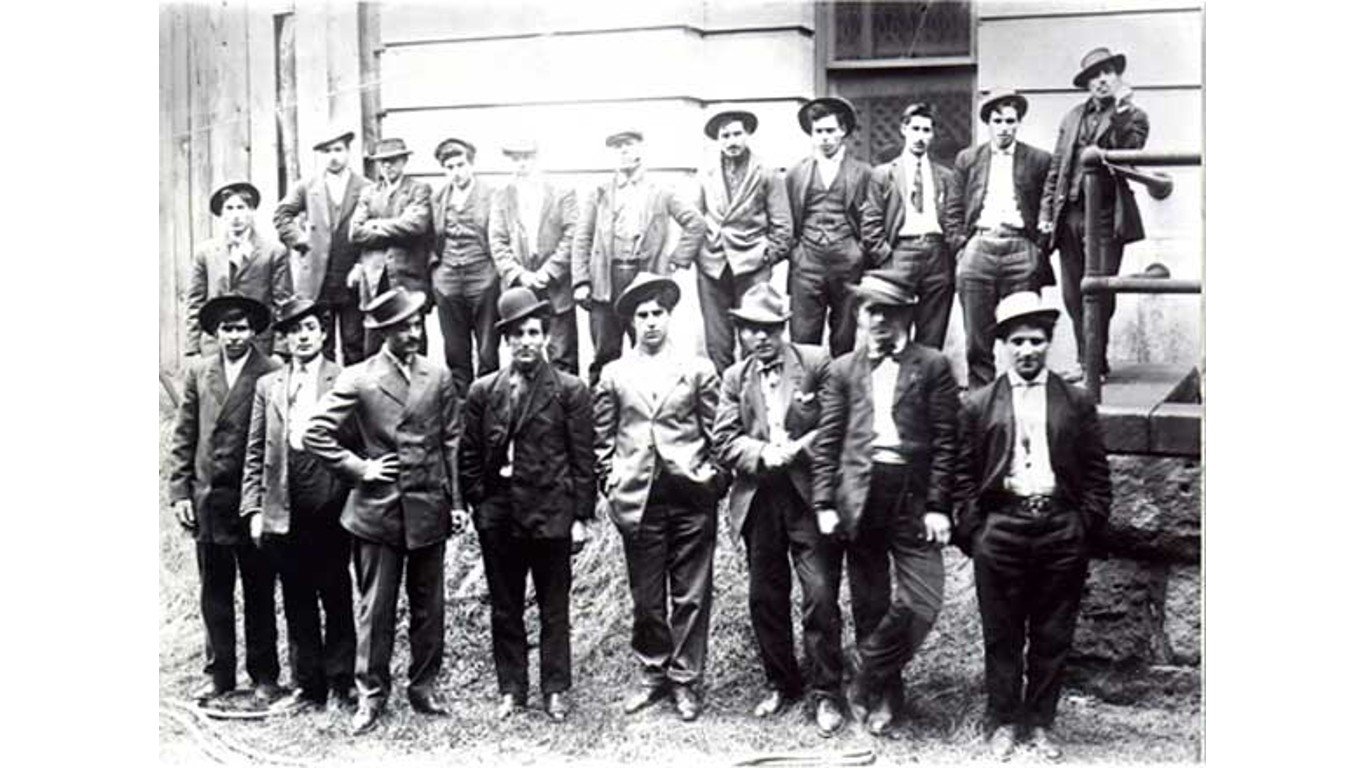
- Place of origin: New York City
- Active years: 1890s-1910s
- Ethnicity: Irish-Italian
The remaining members of the Dead Rabbits, Whyos, and other Five Points gangs were combined by Italian gangster Paul Kelly to form the Five Points Gang in the 1890s. Kelly was able to pull together an army of 1,500 thugs who fought turf battles with other gangs such as the Jewish gang of Monk Eastman. When they weren’t fighting, the Five Pointers operated robbery, racketeering, and prostitution rings. They also worked as muscle for the corrupt Tammany Hall political machine. Before the gang’s influence declined in the 1910s, Kelly mentored future organized crime big shots Al Capone, “Lucky” Luciano, and Johnny Torrio.
Westies
- Place of origin: New York City
- Active years: 1960s-2000s
- Ethnicity: Irish
The “Westies” were an Irish-American criminal gang that operated out of the west side of Manhattan. They used their muscle to intimidate the shipping trade before that industry declined after the 1960s. That, and the gentrification of the neighborhood, led to the decline of the organization, which came under the influence of the Gambino crime family in the 1970s and 1980s. The Gambinos hired some of the gang as contract killers. The Westies had an especially violent reputation – they killed and dismembered victims. Friction between gang founder James Coonan and another member, Mickey Featherstone, developed in the 1980s. Featherstone was arrested on a murder charge. To clear his name, he taped recordings of Coonan and other Westies that led to the takedown of the gang.
Forty Thieves
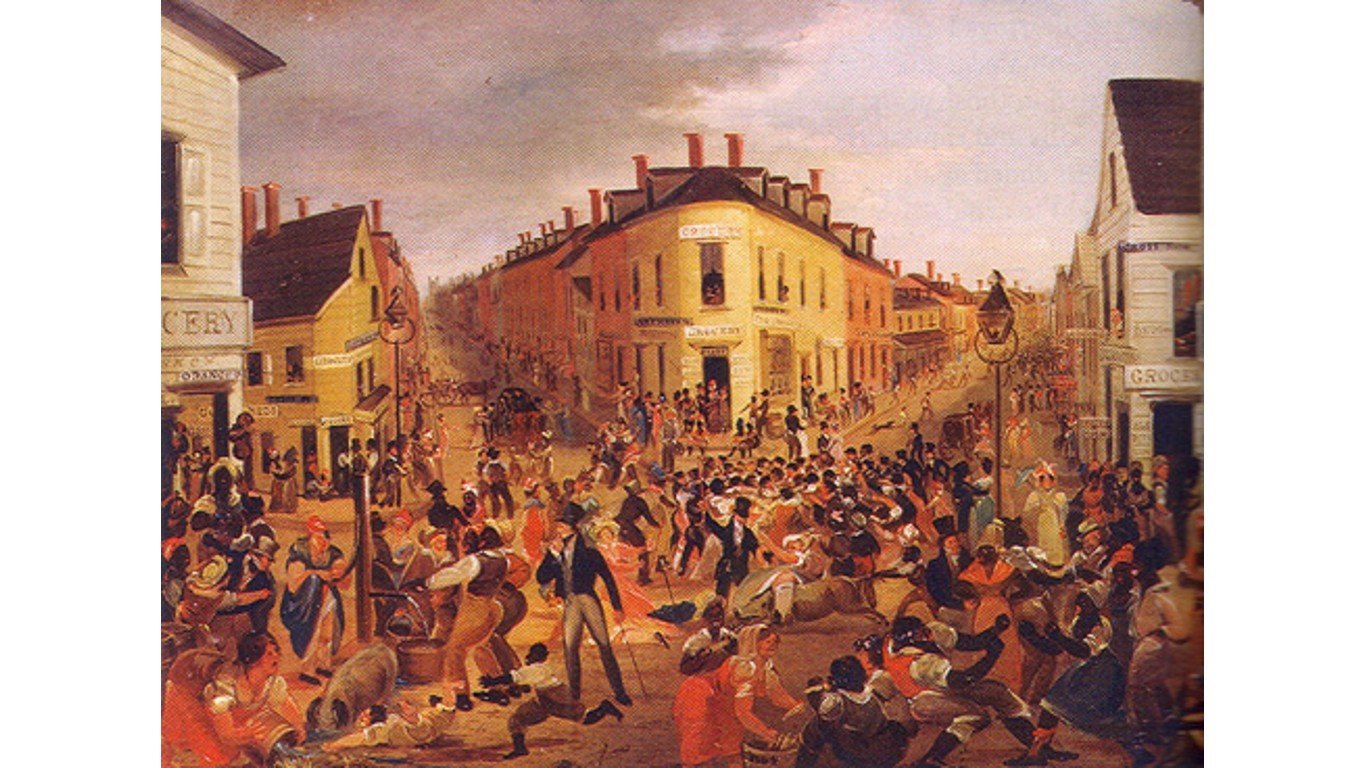
- Place of origin: New York City
- Active years: 1820s-1850s
- Ethnicity: Irish
One of New York City’s earliest gangs, the Forty Thieves operated between the 1820s and 1850s in the Five Points neighborhood of Manhattan. The band was composed of Irish immigrants fleeing religious oppression and famine from Ireland. They were led by Edward Coleman, who organized the disparate group into a structured street gang with its own rules and a hierarchy. Gang members reportedly had to meet a quota of stealing a fixed amount of goods each day or be expelled.
North Side Gang
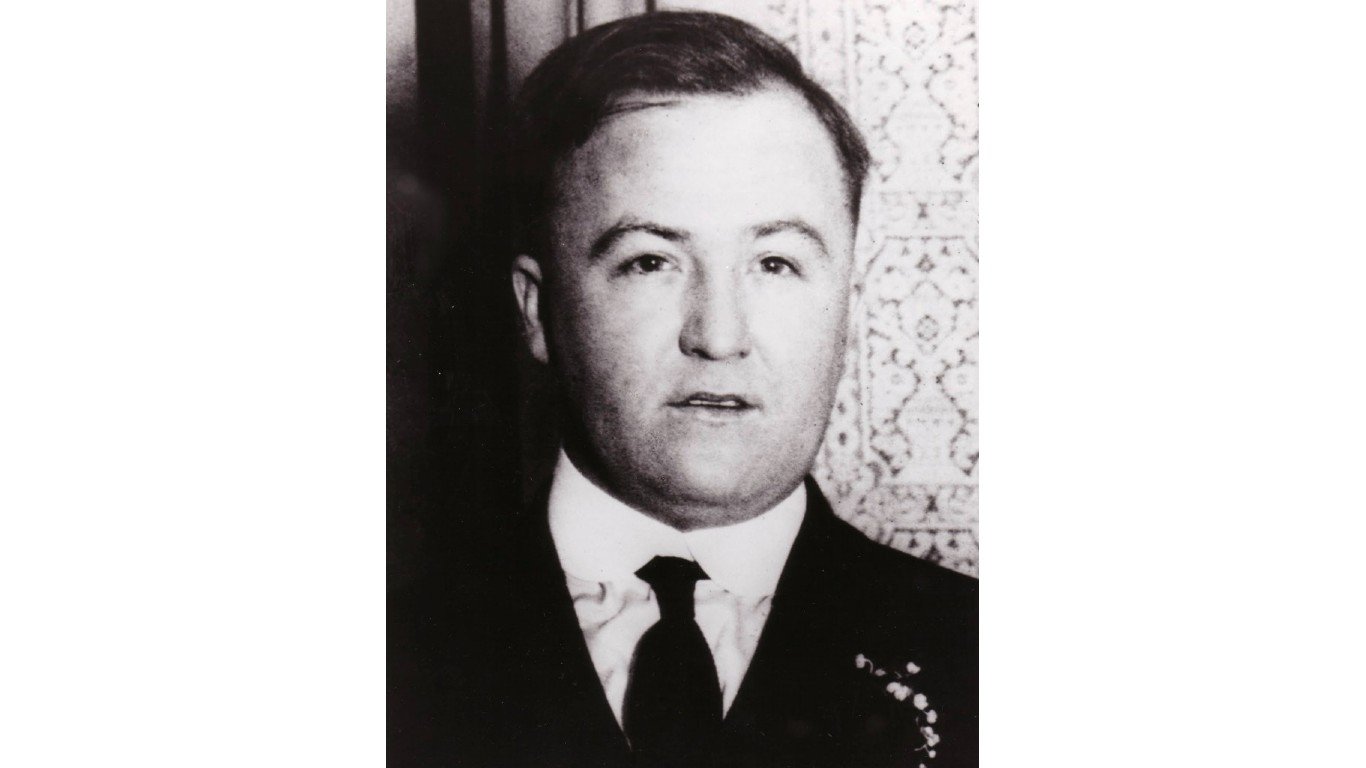
- Place of origin: Chicago
- Active years: 1919-1935
- Ethnicity: Irish, Polish, Italian
This gang, which operated on Chicago’s North Side, was unusual in that it included members of the Irish, Polish, and Italian communities. They were bootleggers who battled for control of that illicit trade with Al Capone’s South Side Gang. Among its leaders were Dean O’Banion, Hymie Weiss, Vincent Drucci, and Bugs Moran. The North Siders were weakened by the assassination of O’Banion, and seven more members of the gang were famously slain in the St. Valentine’s Day Massacre in 1929 – effectively crippling the group for good.
Velentzas Organization

- Place of origin: New York City
- Active years: 1950s-present
- Ethnicity: Greek
The Velentzas Organization is a Greek-American criminal organization based in Queens, and operating around the New York City metropolitan area. It was founded by one “Pete the Greek” Kourakos but took on the name of a later leader, Spyredon “Spiro” Velentzas. The group controlled many illegal gambling operations in the 1980s and early ’90s. It had a close association with the Lucchese crime family but ran afoul of the Gambinos. In 1992, Velentzas was convicted of murder and sentenced to life in prison.

